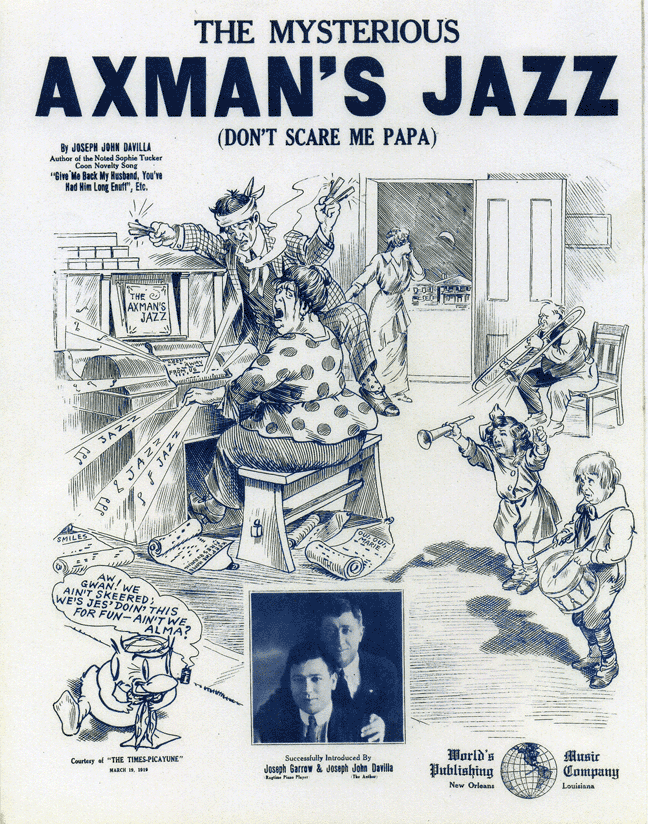The Axeman of New Orleans was an attention-grabbing serial killer who operated in and around New Orleans in 1918-1919 and possibly in 1910-1911. He was never caught. In an incident reminiscent of the later Zodiac killer, someone claiming to be the Axeman wrote a letter to the newspaper, which dutifully published it. This letter is a remarkable little document which, whether authentic or not, makes a marvelous addition to an RPG adventure.
This post is brought to you by beloved Patreon backer Joel Dalenberg. Thanks for helping keep the lights on! If you want to help keep this blog going alongside Joel, head over to the Patreon page – and thank you!

The facts of the case are hazy. From 1918-1919 in New Orleans, someone broke into a series of houses in the middle of the night. Usually, this was done by using a chisel to remove a panel in the back door. The killer picked up an axe inside the house (a common household tool), and attacked the sleepers in their beds. Usually, nothing was taken. There were about a dozen such victims, mostly Italian immigrant grocers and their families. The last murder was in October, 1919. A series of earlier violent breakings-and-enterings in New Orleans from 1910-1911 were just similar enough to suggest a shared perpetrator, but not similar enough to be definitive.
The case has attracted a lot of colorful attention. Like in the Jack the Ripper murders 30 years earlier in London, the police didn’t accomplish much. No one arrested was a serious contender for the title of Axeman. Every ‘true crime’ writer and podcaster to touch the case has created their own preferred explanation, some better-sourced than others. My goal here is not to endorse one solution or another, but to focus on the case’s most peculiar and interesting component: the letter the Axeman of New Orleans supposedly wrote to the public.
In March of 1919, with four (or five) dead in the past year by the Axeman’s hand, the New Orleans Times-Picayune newspaper received a letter claiming to be from the Axeman. They published it two days later. The delay suggests they may not have known quite what to do with it. The letter’s contents follow.

Hell, March 13, 1919
Editor of the Times‑Picayune, New Orleans:
Esteemed mortal: They have never caught me and they never will. They have never seen me, for I am invisible, even as the ether which surrounds your earth. I am not a human being, but a spirit and a fell demon from hottest hell. I am what you Orleanians and your foolish police call the axman.
When I see fit, I shall come again and claim other victims. I alone know whom they shall be. I shall leave no clue, except perhaps my bloody ax, besmeared with the blood and brains of he whom I have sent below to keep me company.
If you wish you may tell the police to be careful not to rile me. Of course, I am a reasonable spirit. I take no offense at the way in which they have conducted their investigations in the past. In fact, they have been so utterly stupid so as to amuse not only me, but His Satanic Majesty, Francis Joseph, etc. But tell them to beware. Let them not try to discover what I am, for it were better that they never were born than for them to incur the wrath of the axman. I don’t think that there is any need of such a warning, for I feel sure that your police will always dodge me, as they have in the past. They are wise and know who to keep away from all harm.
Undoubtedly you Orleanians think of me as a most horrible murderer, which I am, but I could be much worse if I wanted to. If I wished to I could pay a visit to your city every night. At will I could slay thousands of your best citizens, for I am in close relationship with the Angel of Death.
Now, to be exact, at 12:25 o’clock (earthly time) on next Tuesday night, I am going to pass over New Orleans. In my infinite mercy, I am going to make a little proposition to the people.
Here it is:
I am very fond of jazz music and I swear by all the devils in the nether regions, that every person shall be spared in whose house a jazz band is in full swing at the time I have just mentioned. If everyone has a jazz band going, well, then so much the better for the people. One thing is certain and that is some of those persons who do not jazz it on Tuesday night (if there be any) will get the ax.
Well, as I am cold and crave the warmth of my native Tartarus, and as it is about time that I have left your homely earth, I will cease my discourse. Hoping that thou wilt publish this, that it may go well with thee, I have been, am, and will be the worst spirit that ever existed either in fact or the realm of fancy.
The Axeman.

As the killer’s legend has grown over the decades, it is now popular to say that there never was such an evening for jazz as the one warned of by the Axeman – that all of New Orleans blazed with light and music all night long, that every bar and private parlor boomed with live jazz to keep away the demon. In truth, some businesses and private individuals used the letter as an excuse to party, and most of the city ignored it. There was no killing that night.
The date and time in question were the first minutes of March 19th, St. Joseph’s Day. The feast day of the husband of the Virgin Mary and the legal father of Christ was a big deal in the Italian immigrant community of New Orleans: the very community the Axeman seemed to be targeting. It was a day of thanksgiving, charity, feasting, and parties. In 1919, St. Joseph’s Day fell in the middle of Lent, and was going to be a welcome break from the season’s fasting. If the letter was genuine, it was another targeted attack on New Orleans’ Italian immigrants. If it was a hoax, the timing was a dick move.
The text of the letter is curious. The author was literate enough to make allusions to Tartarus and ape the letters supposedly sent by Jack the Ripper to the police. But he or she nonetheless closed with a sort of “Well, I’d best be going now” typical of casual letters and letters from children. A letter isn’t a conversation, nor does it have to be written in a single sitting. You don’t have to make excuses for ending it, and even if you did, chronological or circumstantial excuses (“I am cold and crave the warmth…”) are nonsensical. So the author is in a real awkward middle ground of literacy.
Ditto the references to “nether regions” and Francis Joseph. “All the devils in the nether regions” is clearly supposed to be a reference to hell. In a different context, it would be a pun about someone’s genitals, but I don’t see the pun here. Francis Joseph, mentioned in the same breath as Satan, was the Austro-Hungarian emperor who died three years earlier. Maybe he’s listed because he was an enemy of America who died recently? It’s unclear and consistent with the author being educated, but not that educated.

It is possible the letter was a publicity stunt by a local songwriter named Joseph John Davilla. He wrote a novelty song called The Mysterious Axman’s Jazz (Don’t Scare Me, Papa). In this era before radios and records were universal, you made money off your songs by selling sheet music. Davilla’s sheet music wasn’t ready in time for Tuesday night, but he placed advertisements in the Times-Picayune and hired a pianist to play the song continuously while being pulled up and down Canal Street in a wagon. Wednesday morning, the Times-Picayune published a cartoon showing a family fearfully playing music and watching the door. Davilla licensed the cartoon as the cover for his sheet music. When the piece finally came out, Davilla earned a pretty penny on his scheme. Of course, that’s proof of nothing but tastelessness; he could have simply smelled an opportunity and rebranded a piece he was already working on.
At your table, creating a fictionalized version of the Axeman and his letter is a great way to drop your PCs into the middle of a serial killer investigation. You don’t want to send them to investigate after the first weird murder, otherwise you run into the X-Files problem: Mulder and Scully arrive in a town that’s seen a bizarre killing, and have nothing to do but hang out until there’s a second murder and the clues are fresh enough to pursue. At your table, there have instead been four or five weird murders, but the arrival of this letter is a development strange enough to warrant calling in outside help. Maybe the mayor is dissatisfied with her constables’ efforts and wants your adventuring party to take over the case. Maybe the planetary governor just brings the PCs in as consultants with a fresh perspective. Either way, enough evidence has accumulated that the PCs have options when they decide where to start their investigation. First, though, they should probably decide whether this bizarre letter should be published.
For your fictional letter, you can probably use the Axeman’s letter more or less as-is. Swap out the references to jazz, Tartarus, and Francis Joseph for something more appropriate to your setting. If your weird serial killer has a different M.O. than braining folks with their own axes, insert references to that too. You’ll also need to decide whether the letter is real or a hoax. Personally, I’d split the difference: the letter-writer isn’t the killer, but she has ties to him, so tracking down the author is still worthwhile.
You may also want to turn the letter into a physical prop, if you’re into that sort of thing. I once made some prop letters, aged them with tea, and burned the edges, but I probably won’t again. It just didn’t feel worth the effort. Having a good prop at the table is amazingly fun, but it’s a lot of work. A current GM of mine is good at props. If you’re like her, sure, make a prop letter with an ‘accidental’ thumbprint and additional details concealed in invisible ink. If you’re like me, printing out a handout in a handwriting font is probably good enough.
–
Source: The Axeman of New Orleans: The True Story by Miriam C. Davis (2017)






